#kondo shusuke
Explore tagged Tumblr posts
Note
I am trying to find info on a friend of the Shinsengumi . He was known for having lost his hand in battle . He went all through the Boshin war only to be so badly wounded at Goryokaku that Enemoto had to overdose him on morphine .
I believe he was of higher rank than Hijikata but the two got on well . Sorry I can’t even remember his name?
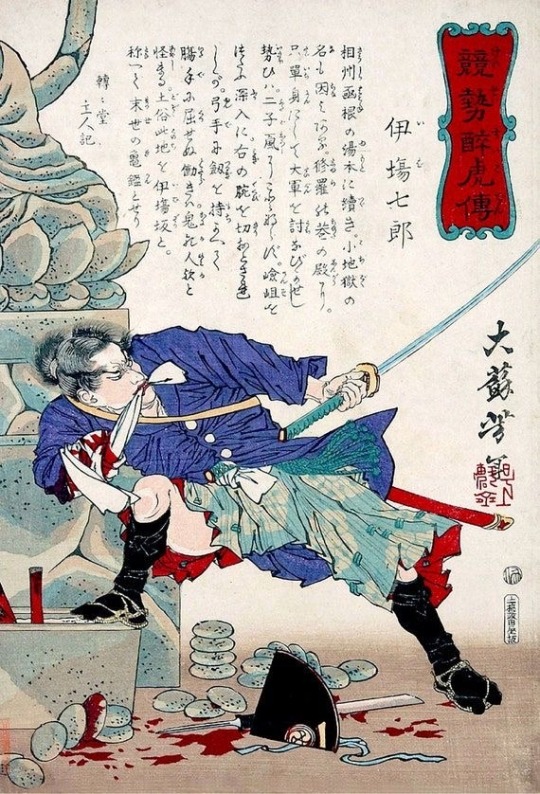
That would be Iba Hachiro.
You could read more about him here and here.
He was friends with Hijikata back when they were students in Edo (source), and he used to visit the Shieikan Dojo "for fun every three days or so". Here's an interesting anecdote:
Kondo Isami’s adoptive father, Kondo Shusuke, the third generation master of Tennen Rishin-ryu, gave up his position to Kondo Isami and lived a retired life. He often liked to go listen to kodan storytellers. After listening to the story, when he returned to the Shieikan, he would gather Kondo Isami, Hijikata Toshizo, Okita Souji, Nagakura Shinpachi, “Iba Hachiro who came for fun every three days or so”, and others, and reenact the three parts by himself over bowls of mori soba noodles. While everyone was eating soba, Kondo Shusuke would talk about the contents of the story of the day. Everyone would listen quietly as they ate, but Iba Hachiro, who finished eating first, would go off somewhere, and then one or two people would leave their seats. In the end, only Kondo Isami was still listening to Shusuke, and the two of them would laugh to each other’s face. This was an anecdote introduced by Fukuchi (Fukuchi Ouchi, a student at the Shieikan who wrote a book “剣豪秘話”). (source)
In Hakodate, Iba became the head of infantry entrusted with the 1st Regiment and 2nd Battalion, consisting of guerrilla forces, the Shinsengumi, and the Shogitai (source). Hijikata was the General of the Kando Army (source), in other words, the commander-in-chief of the ground forces (source). I'm not sure who was ranked higher 😅
Tamara Ginnosuke, who was there during Iba's death, provided an eyewitness account many years later:
at the end of the Boshin War in Hakodate, Iba Hachiro was offered sake poisoned with morphine by Enomoto. He laughed and drank it heartily to end his own life. (source)
This site contains a very detailed biography of Iba Hachiro. It's in Japanese, but I might translate it later :)
24 notes
·
View notes
Photo









#uss enterplaid#kondo isami#fude#kondo shusuke#shinsengumi!#taiga kondo#katchan loves haiqueue man#you cant even make this up#long post
15 notes
·
View notes
Text
100Koi+ 4th Anniversary Party Room (Part 2)
➡️ Part 1
💟 Since 2014
Be My Princess Season 2
The prince 50 years later is also here!
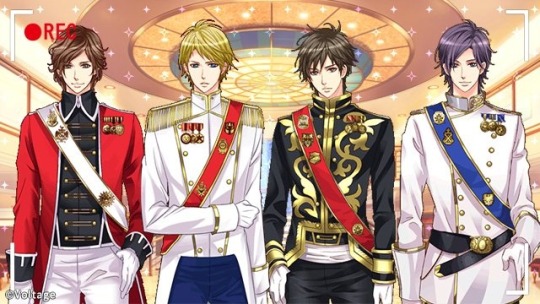
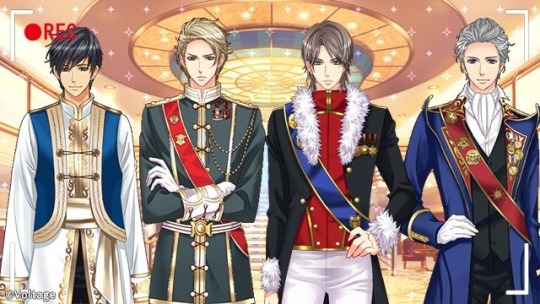
Hayden A. Spencer | Kuon J. Casiraghi | Sieg Lieben | Oliver Button | Ivan Chernenkov | Aslan Mafdir | Kevin A. Alford | Maximillion Levaincois
_
Enchanted in the Moonlight
Youkai also came to the venue...!
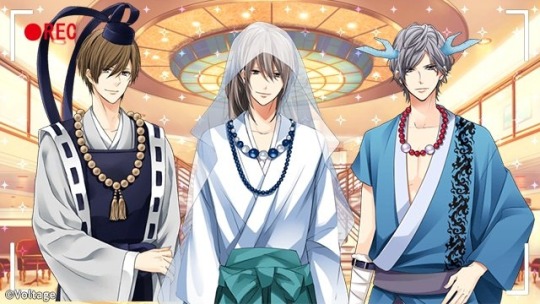
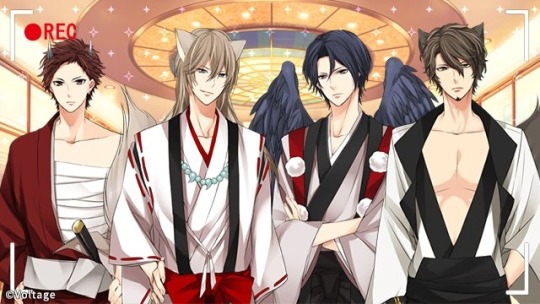
Miyabi | Chikage | Shinra | Kyoga | Yukinojo | Samon | Kiryu
_
In Your Arms Tonight Season 2
Today everyone here...!

Takeru Ashida | Shinichiro Ogiwara | Shu Mishima | Fumitaka Nishi | Kazuya Seta | Ryosuke Sakura
_
Finally, in Love Again
Today everyone here...!
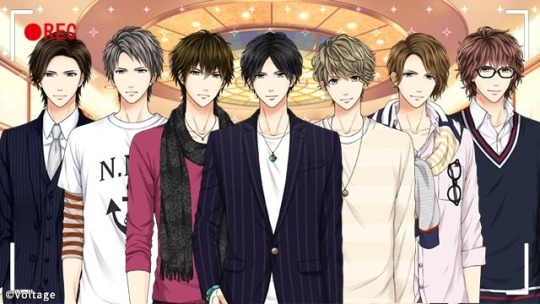
Aki Fujishima | Shuichiro Momoi | Sosuke Kikuchi | Yoh Kobayakawa | Yuto Tsuruya | Kazuki Serizawa | Kanata Tachibana
_
True Love Sweet Lies
We invited detectives today!

Kiyoharu Nanahoshi | Sakuya Nanahoshi | Rui Wakaba | Naomasa Sakura | Nozomu Fuse
_
Her Love in the Force
All the public security detectives are now in the match!

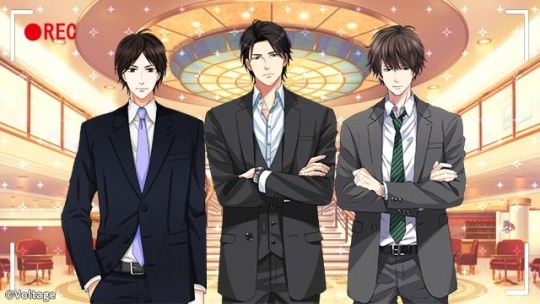
Seiji Goto | Hyogo Kaga | Hideki Ishigami | Shusuke Soma | Ayumu Shinonome | Jin Namba | Toru Kurosawa | Takaomi Tsugaru
_
Star-Cossed Myth
The god of the constellations also came...!


Leon | Scorpio | Teorus | Dui | Huedhaut | Ichthys | Karno | Zyglavis | Aigonorus | Krioff | Tauxolouve | Partheno
_
Scandal in the Spotlight
There were also national idols...!
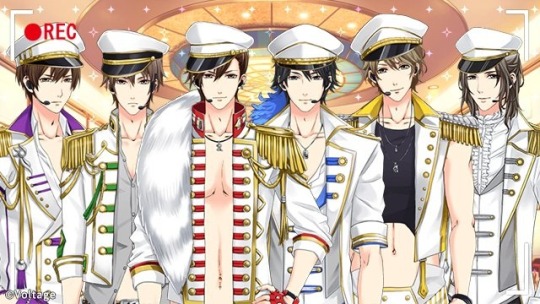

Kyohei Rikudoh | Iori Enjo | Kota Igarashi | Nagito Aoshima | Takashi Ninagawa | Ryo Chibana | Ritsuto Ena | Fumito Ena
_
My Wedding and 7 Rings
All of Sanno Shoji are here!
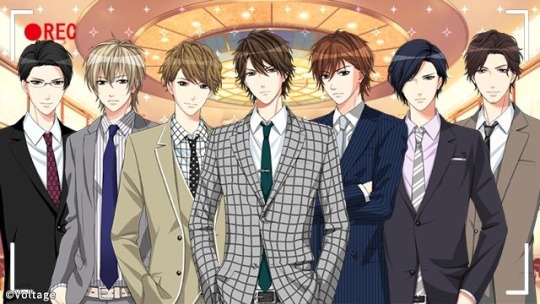
Asahi Kakyouin | Yamato Kougami | Junta Nikaido | Hiroto Chitose | Ren Shibasaki | Kai Fujisawa | Seiichirou Hayami
_
💟 Since 2015
My Last First Kiss
Today are my childhood friends...!
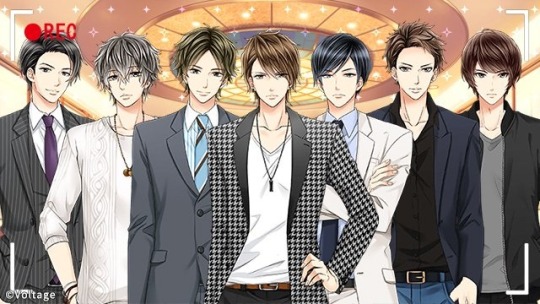
Ayato Hidaka | Ichiya Misono | Makoto Morimachi | Takamune Kitami | Riku Morimachi | Hiroki Eniwa | Rin Yakumo
_
Butler Until Midnight
There were also butlers...!
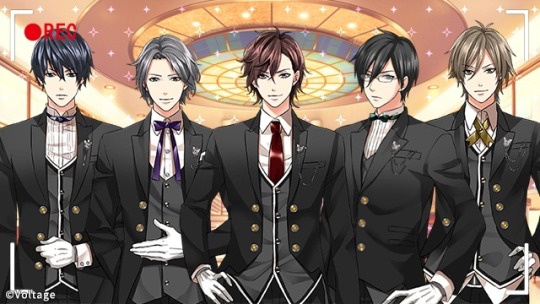
Yuma Akagi | Aoi Shirafuji | Tomoki Matsuba | Kyo Aizawa | Itsuki Matsuba
_
After School Affairs
Everyone at Kiyoharu High School is now available!
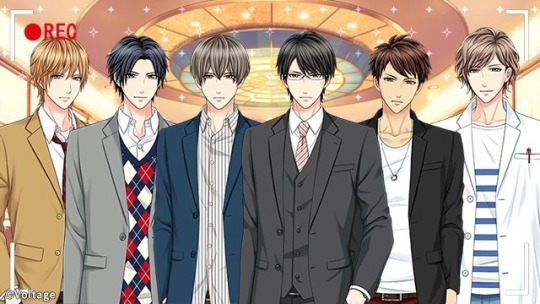
Shinichi Kagari | Kiyonori Taishi | Rikiya Mononobe | Hidetaka Sera | Kenzo Yasukawa | Chiharu Utsumi
_
Bad Boys Do it Better!
Today, everyone from Shinran High School is here!
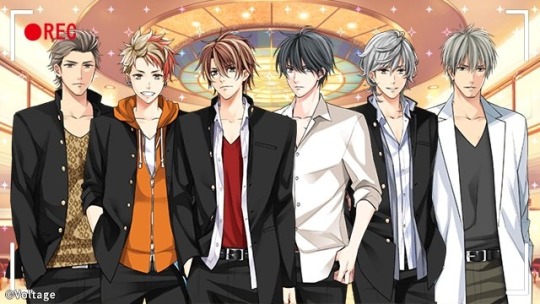
Ryoji Ryukai | Rei Todo | Yu Agatsuma | Akira Sakaki | Keiichiro Minase | Yuki Saejima
_
Era of Samurai: Code of Love
Over time from the end of the Edo period...!
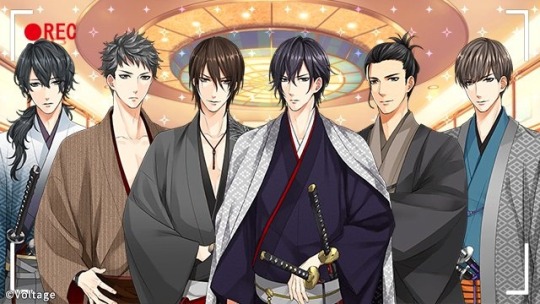
Toshizo Hijikata | Soji Okita | Sanosuke Harada | Hajime Saito | Isami Kondo | Shinsaku Takasugi
_
💟 Since 2016
Dangerous Seduction
We invited all of you today!
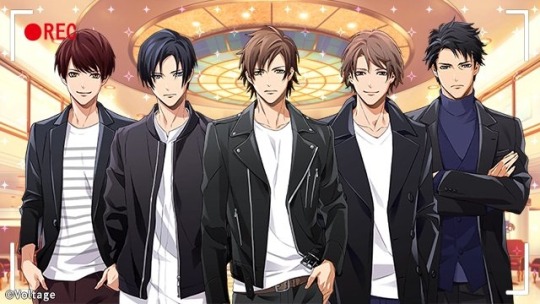
Masaharu Ryuzaki | Yasumi Arimura | Haruma Fujioka | Asuka Hino | Kentaro Inui
_
Irresistible Mistakes
Pheromen are also available here!

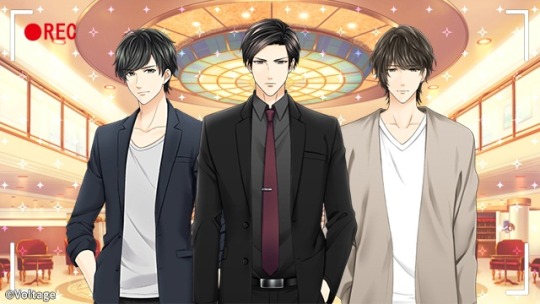
Shunichiro Tachibana | Toshiaki Kijima | Toma Kiriya | Taku Hayama | Go Okubo | Natsume Asaoka | Yukihisa Maki | Keita Miura | Rei Kamiki | Jun Araki
_
Love Brings You Home
Everyone here is here today!
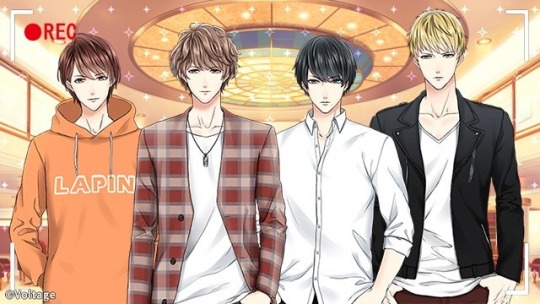
Taiyo Inami | Arata Yuki | Liam Kurusu | Hazuki Tojo | Yoshiro Fukumoto
_
💟 Since 2017
When Destiny Comes Knocking
There were also regulars of Jesus!
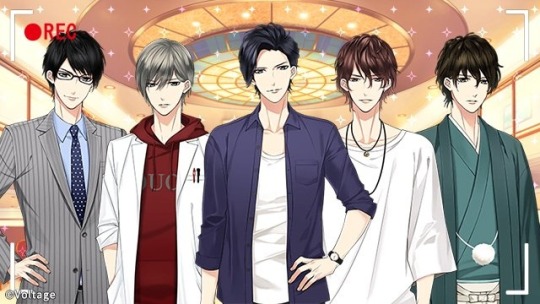
Nozomu Kaneko | Rheo Usami | Seiya Fushimi | Wataru Toge | Shintaro Ando
_
Rose in the Embers
You came from the imperial capital of the Taisho era!
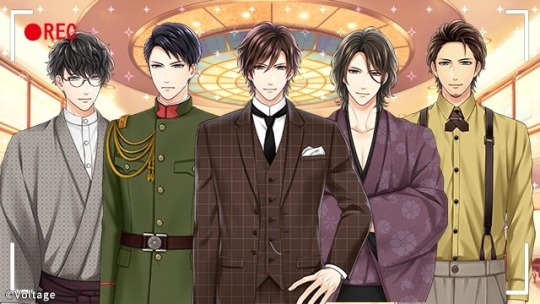
Kyosuke Takatsukasa | Takahisa Togo | Misao Higuchi | Tsukumo Kobayakawa | Atsuro Shibusawa
_
Our Private Homeroom
There were also teachers from Shirogaoka High School...!
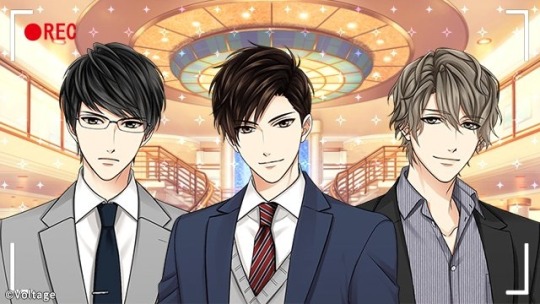
Ryota Mochizuki | Yohji Furuya | Shuya Komaki
_
Kings of Paradise
The best men are now available...!
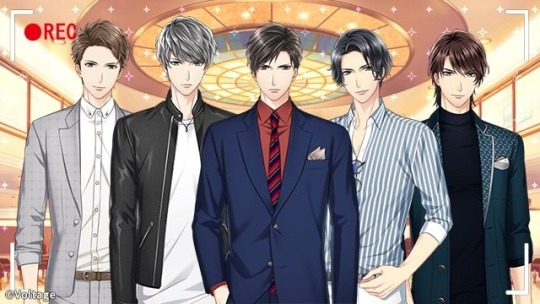
Taki Kozaki | Kiyohito Shirakami | Shun Randoh | Yosuke Sagara | Kaisei Kuon | Hayachika Ryutsubaki | Blood Moon / Sakuto Amatsuka
_
💟 Since 2018
A World With(out) You
Tonight, these guys also came to see you again.

Kotaro Kamiyama | Saku Fukazawa | Kento Miyoshi | Kiyohiro Amemiya
_
Masquerade Kiss
Today, these people have a slightly dangerous scent...!
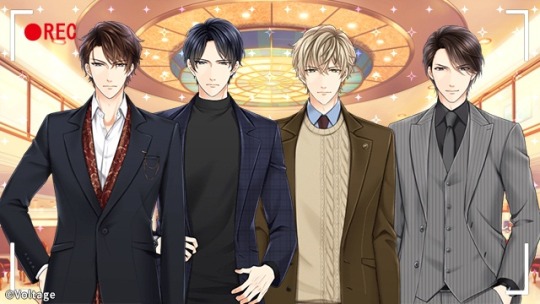
Kazuomi Shido | Yuzuru Shiba | Kei Soejima | Boss / Seiichi Setoyanagi
_
Romance MD: Always on Call
There were also members of the Seikai University Hospital and the Special Lifesaving Department...!

Munechika Takado | Tetsuya Hosho | Kyogoku Sentaro | Matsunaga Eiichi | Toshiki Kasumi | Kaede Ekuni
_
💟 Since 2019
Destind: Mr. Almost Right
All of these people, who are rarely gathered together, are all together today!
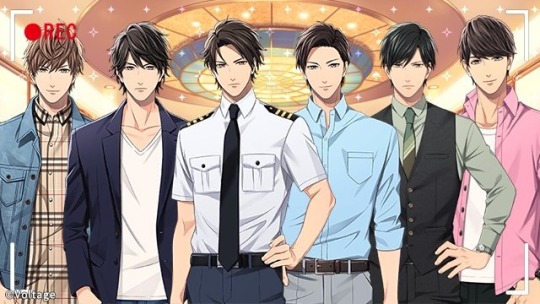
Rei Rindoh | Araya Kuze | Takane Momochi | Ryogo Saikusa | Haruma Tosaka | Yuri Kazumoto
_
Love's Hella Punk
He rushed to see you today!
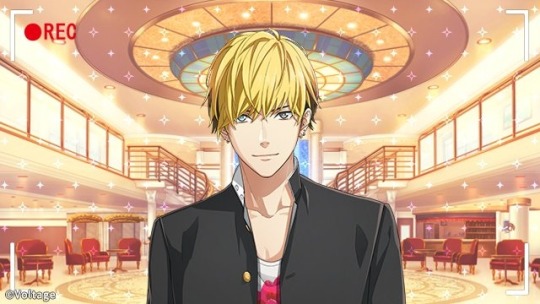
Tengoku Shima | Tatsunoshin Utsuki | Daiki Hazeki | Akira Kousaka
_
💟 Since 2020
Professional Boyfriend
These two are also the same...!
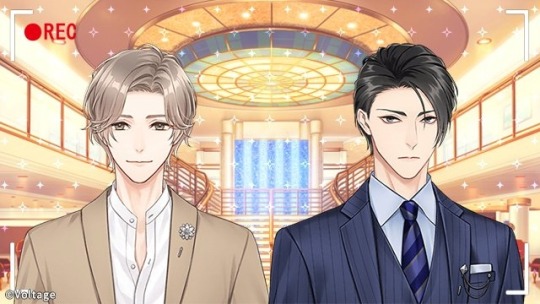
Banri Saki | Ikki Tatsumi
_
💟 Since 2021
Oops, I Said Yes?!
The last is...! These people came from Miyoshi Kukansha Co., Ltd.!

Kunihiro Kasai | Kiba Kuranosuke | Shu Hasunuma | Eiji Takao | Sengawa Ukyo
#Voltage Inc#Love 365#100シーンの恋+#100恋+#Otome Romance#Otome Games#100 Love+#the 4th anniversary#Japanese Version#Titles 61 & Characters 396#Part 2
233 notes
·
View notes
Text
2019 2.5D Actors ranking
I decided to do two rankings of my top 50 2.5D actors. One in terms of acting skill and level, and one in terms of how much I like them. RULES: 1. They must still be active in 2.5D shows. (Bar Hirose Tomoki because I love him so much) 2. I have not taken their acting level into account. That is not to say they are bad actors but that hasn’t been taken into account when ranking. Please don’t get offended, these are my opinions. In the brackets I have the roles that really made me love them as an actor. So here is the ranking:
1. Tomose Hiroki (Makishima Yuusuke)
2. Taguchi Tsukasa (Kikumaru Eiji)
3. Honda Reo (Kikumaru Eiji, Ikaruga Misumi)
4. Hiramatsu Raima (Tooyama Kintaro)
5. Sana Hiroki (Kaidoh Kaoru, Maraich)
6. Noguchi Jun (Sakisaka Muku)
7. Yamamoto Ikkei (Rinkai Line/Yamagata Shinkansen)
8. Miura Hiroki (Atobe Keigo, Higekiri)
9. Sato Yugo (Kisarazu Atsushi/Kisarazu Ryo)
10. Tamura Shogo (Akutagawa Jirou)
11. Ota Motohiro (Bloom, Ibu Shinji, Takasugi Shinsaku)
12. Tanaka Ryosei (Joetsu Shinkansen, Arisugawa Homare)
13. Tateishi Toshiki (Yukimura Seiichi, Chigasaki Itaru)
14. Maekawa Yuuki (Minagi Tsuzuru)
15. Kiyama Haruki (Tomoegata)
16. Furuya Yamato (Citron)
17. Ishida Shun (Oishi Shuichiro)
18. Aramaki Yoshiko (Yamanbagiri Kunihiro)
19. Suzuki Hiroki (Mikazuki Munechika, Arakita Yasutomo, Komaeda Nagito)
20. Tamura Shin (Mutsunokami Yoshiyuki)
21. Tamaki Yuki (Toudou Jinpachi, Snake, Kogarasumaru)
22. Maeda Ryutaro (Kirihara Akaya)
23. Nakamura Taro (Hyodo Juza, Niiboshi Reo)
24. Naya Takeru (Sayo Samonji)
25. Yamagata Yuki (Clear)
26. Itagaki Rihito (Nagano Shinkansen/Joetsu Line)
27. Tanimizu Riki (Nansen Ichimonji)
28. Atsuki Mashiko (Shiraishi Kuranosuke)
29. Kuroba Mario (Kise Ryouta, Mikazuki Munechika)
30. Miyagi Koudai (Mizuki Hajime, Sanada Jyuuyushi)
31. Ueda Keisuke (Nakahara Chuuya, Japan, Mikage Hisoka)
32. Shiota Kouhei (Tanaka Ryunosuke, Sakamoto Ryuji)
33. Sakamoto Shogo (Echizen Ryouma, Horikawa Kunihiro)
34. Miyazaki Yu (Rurikawa Yuki)
35. Ino Hiroki (Protagonist – Persona 5, Sugawara Koushi)
36. Ozawa Ren (Toudou Heisuke, Jyuishimatsu, Sawamura Eijun)
37. Araki Kentaro (Minamoto no Yoshitsune)
38. Izaki Ryujiro (Kamio Akira)
39. Kawasaki Yusaku (Jackal Kuwahara)
40. Takasaki Shouta (Kikumaru Eiji, Yamazaki Susumu, Tobu Tojo Line/Shin’etsu Line)
41. Sasaki Yoshihide (Shiraishi Kuranosuke, Druitt, Akechi Goro)
42. Akazawa Tomoru (Miyoshi Kazunari)
43. Tauchi Tokihiro (Sakoda Ken)
44. Baba Ryoma (Seibu Seibuen Line)
45. Takamoto Gaku (Prussia)
46. Raita (Shigaraki, Chinen Hiroshi)
47. Nagata Takato (Kozume Kenma)
48. Hashimoto Taito (Fuji Shusuke, Seibu Shinjuku Line)
49. Kujirai Kousuke (Teshima Junta, Tokkaido Main Line)
50. Kondo Shouri (Kuroo Tetsurou)
6 notes
·
View notes
Text
The Prince of Tennis Anime to Celebrate Its 20th Anniversary at Special Event on October 10
To celebrate its 20th anniversary, The Prince of Tennis anime franchise will hold a special event "TeniPri 20th Anniversary Event -Future-" at Tokyo Dome City Hall in Tokyo on October 10, 2021. "A Prince Appears," the first episode of the TV anime series based on Takeshi Konomi's sports manga, was aired in Japan on October 10, 2001. Then, the TV anime sequel, OVAs, and films continue to be produced.
The main voice cast members of Seishun Academy are scheduled to be appeared on the stage to celebrate the memorial day - Junko Minagawa (Ryoma Echizen), Ryotaro Okiayu (Kunimitsu Tezuka), Takayuki Kondo (Shuichiro Oishi), Yuki Kaida (Shusuke Fuji), Kenjiro Tsuda (Sadaharu Inui), Hiroki Takahashi (Eiji Kikumaru), Naru Kawamoto (Takashi Kawamura), Masaya Onosaka (Takeshi Momoshiro), and Kohei Kiyasu (Kaoru Kaido).
【情報解禁①】 アニメ #テニプリ 20周年のアニバーサリーイヤー初日である2021/10/10に…! ????20周年記念イベント???? 「テニプリ 20th Anniversary Event -Future-」開催決定!! 青学メンバーが大集合します???????????? 詳細はHPをチェック!https://t.co/Mo9GTggukg#テニプリ #テニプリ20th pic.twitter.com/sBYgW0bj5j
— アニメ「新テニスの王子様」公式 (@shintenianime) May 9, 2021
The 20th anniversary logo features school colors of the ten schools - Seishun Academy, Fudoumine Middle School, St. Rudolph, Yamabuki Middle School, Hyoutei Academy Secondary Department, Rokkaku Middle School, Rikkaidai Junior High School, Higa Middle School, Shitenhoji Middle School, and U-17.
【情報解禁②】 20周年ロゴも同時解禁!!!#テニプリ に登場する計10校(チーム)のカラーが『20』の文字を鮮やかに彩ります????????✨ 青学/不動峰/聖ルドルフ/山吹/氷帝/六角/立海/比嘉/四天宝寺/U-17 今後の展開にご期待ください!!#テニプリ20th pic.twitter.com/CIdxnMbrbJ
— アニメ「新テニスの王子様」公式 (@shintenianime) May 9, 2021
And from May 10 to October 10, all episodes of The Prince of Tennis anime franchise will be streamed sequentially from its first episode at 21:00 (JST) on weekdays on the franchise's official YouTube channel.
【情報解禁③】 10/10まで????????#テニチャ にて、アニメ「テニスの王子様」シリーズを平日限定で1話目から順次配信する #毎晩テニチャ 企画が5/10よりスタート????! 平日21時より毎晩プレミア公開予定♪ (アーカイブなし) ▼テニチャhttps://t.co/UvHZc4hcHx#テニプリ20th pic.twitter.com/E3CzIW5ZY1
— アニメ「新テニスの王子様」公式 (@shintenianime) May 9, 2021
Source: "The New Prince of Tennis" anime official website / Twitter
© TAKESHI KONOMI/SHUEISHA, NAS, THE PRINCE Of TENNIS II PROJECT
By: Mikikazu Komatsu
0 notes
Photo

After wikipedia related in Japanese script: Born in 1837 as the eldest daughter of Yajugoro Matsui, a vassal of the Tokugawa Shimizu family.
On March 29, 1860 (1860), he marries a match with Isamu Kondo, the next fourth generation of natural science. Kondo is the third son of a peasant, Kujiro Miyagawa, in Kamiishihara-mura, Tama-gun, Musashi-kuni (Tokyo, Japan), and in the first year of Kaei (1848), the Edo Ushigome natural-risk dojo (Senjokan) He was introduced to Shusuke Kondo, and was adopted by Shusuke on October 19, 2nd Kaei. She gave birth to the eldest daughter, Tama, in 1862.
In the 3rd year of Bunkyu (1863), Isamu, who had succeeded to the guard station, formed a new selection group as a samurai group, but he was active in the Kyoto political affairs and became a retainer of the Aizu clan. During the Boshin War, in 1868, he embarked on a shogunate warship and returned to Edo to reorganize and reorganize the unit, but in April of the same year, a new government army was established at Shimosakoku Nagareyama (Nagareyama City, Chiba Prefecture). Arrested and executed.
Tsune hides with her daughter Tama (6 years old) and her daughter-in-law Yugoro Miyagawa (17 years old) at Hongo Village Seiganji Temple. After the Meiji Restoration, he moved to his brother-in-law, Otogoro Miyagawa. He died in 1892 (Meiji 25). https://www.instagram.com/p/CEQz2t8JC7s/?igshid=1a8kuynb9qzd2
0 notes
Text
The Ruins of Kondo Isami's Dojo

The Shieikan Dojo is the site of Kondo Isami's Tennen Rishin-ryu dojo in Shinjuku Ward.
Currently, only the pillar and the nearby Inari Shrine remain. In this article, we will take a look at the ruins of the Shieikan.
Directions
Address: 25 Ichigaya’yanagi-cho, Shinjuku-ku, Tokyo
How to get there: 3 minute walk from Ushigome Yanagimachi Station on the Oedo Line

Map of the ruins of the dojo
The site of the Shieikan Dojo today
Pillar left in Ushigome Yanagicho, Shinjuku-ku

Shieikan pillar
In Ushigome Yanagicho, Shinjuku Ward, the "Shieikan Ruins" pillar still remains.
The surrounding area is a residential area, and there is nothing left from those days except the Inari Shrine near the dojo.
Inari Shrine (Shoichii Inari Shrine)

Inari Shrine (Shoichii Inari Shrine)
This is a shrine known as "Shieikan Inari", officially "Shoichii Inari Shrine". It's said all the time in the local area that "There was a dojo near Inari". Due to deterioration, it's currently only visible from outside an enclosure.
It is said that this Shieikan Inari has been around for 350 years. Older people in the area sometimes pray at this shrine. It seems that Shinsengumi members also visited.
Theories about the location of the Shieikan
It is said that the site of the Shieikan was in "Yanagimachi", and there was a theory that it was in Yanagimachi, Koishikawa, and a theory that it was in Ushigomeyanagicho, Ichigaya.
The diary written by Shinpachi Nagakura in the early Meiji era was published in Heisei, and made it certain without doubt that it was in Yanagimachi, Ichigaya, where the pillar is currently located.
People related to the Shinsengumi who were at the Shieikan

The ruins of the Shieikan are in the back of this alley
Dojo master Kondo Isami and his disciples
First of all, there was Kondo Isami, the master of the dojo.
He was adopted into this dojo by the 3rd generation Shusuke Kondo and became the 4th generation of Tennen Rishin-ryu.
In addition, among the future members of the Shinsengumi, Hijikata Toshizo, Okita Souji, and Inoue Genzaburo were disciples who learned the Tennen Rishin-ryu there from the start.
Sannan Keisuke and Saito Hajime were disciples who came to the Tennen Rishin-ryu after studying in other schools.
Sannan Keisuke is a swordfighter who studied the Ono-ha Itto-ryu and Hokushin Itto-ryu, but I think he was treated as a disciple rather than a freeloader because he was in a position to go to and teach Tennen Rishin-ryu in Tama many times.
Saito Hajime practiced the Mugai-ryu swordsmanship.
It is said that he was in the Shieikan according to Nagakura Shinpachi's diary and the "両雄士伝" written by Kojima Shikanosuke.
Shinsengumi member Abe Juro, who later joined the Goryo-eiji, also left a sentence that can be taken as confirming that Saito Hajime was in the same school as Okita Souji.
However, Saito Hajime did not participate in the formation of the Roshigumi at Denzuin Temple (5th day of the 2nd month, Bunkyu 3), and when the Roshigumi signed a petition on the 10th day of the 3rd month that they wanted to stay in Kyo.
From this, we can see that Saito Hajime joined the Shinsengumi separately for some reason.
Kondo Isami once asked his adoptive father, Kondo Shusuke, to send bugu (training equipment) for his disciples and freeloaders who lived in the Shieikan. It is said that Saito Hajime did not live in the Shieikan and was not a regular disciple because Saito Hajime was not on the list to send this equipment. There is also a theory that he wasn't actually in the Shieikan.
The freeloaders Nagakura Shinpachi, Harada Sanosuke, and Todo Heisuke
Nagakura Shinpachi, Harada Sanosuke, and Todo Heisuke were studying at other schools, but they were at the Shieikan as freeloaders.
Harada Sanosuke's name is missing from the members of the Roshigumi that Nagakura Shinpachi wrote in his diary, but when the Roshigumi was formed at Denzuin, he was listed in the same group as the members of the Roshigumi.
However, Nagakura Shinpachi had his bugu equipment sent to Kyoto from the Shieikan, but Harada Sanosuke and Todo Heisuke do not have that record.
From this, it is unknown how often Harada Sanosuke and Todo Heisuke stayed the Shieikan.
Iba Hachiro who was at the Shieikan
Another person who is said to have been at the Shieikan is Iba Hachiro, who later fought beside Hijikata Toshizo in the Battle of Hakodate.
In the book "剣豪秘話" written by a disciple Fukuchi Ouchi, who had an exchange with Kondo Isami, it is written that "Iba Hachiro came for fun every three days or so."
Was Katsura Kogoro ever there?
There is no particular record that Katsura Kogoro went in and out of the Shieikan.
Katsura Kogoro was in a dojo called "Renpeikan", which is about a 30-minute walk from the Shieikan, and At the "Kenheikan", the Shieikan once asked the Kenheikan for assistance in a competition against another school.
It wasn't Katsura Kogoro who came to help, but in novels, creative works, dramas, etc., there are times when the story was adapted to suit the narrative.
It is said that the Renpeikan also held tournaments with other training halls, which seems to supporting the idea that they were acquaintances.
The Renpeikan Dojo
The training hall was built near Yasukuni Shrine and was moved during the Meiji era to build the shrine. A monument remains near the south gate of the shrine. In addition to Katsura Kogoro, Takasugi Shinsaku and Ito Hirobumi were also students of this training hall.
Anecdotes about the Shieikan Dojo
There are some anecdotes about the Shieikan at that time in the "剣豪秘話" written by the disciple Fukuchi Ouchi, who interacted with Kondo Isami.
A simple but well-maintained dojo
According to Fukuchi, the Shieikan looked shabby from the outside, but after going inside, even though it was all-male household, it was neat and well-kept from top to bottom.
In other dojos at that time, the tatami mats were often stained and faded, and the fusuma (sliding screen) torn, but that kind of negligence was not seen at the Shieikan.
The "Nihon Gaishi" (history book) on Kondo Isami's desk
Reading "Nihon Gaishi" was popular among the intellectuals at that time.
Fukuchi says that he saw the book half-opened on Kondo Isami's desk in the Shieikan.
Anecdotes about Kondo Shusuke and Hijikata Toshizo
The third generation master, Kondo Shusuke, seems to have been in a quiet retirement.
However, only the shinbunjitsu ceremony in which a student officially becomes a disciple was strictly based on the old ritual, and required a month of preparation.
There is an anecdote that Hijikata Toshizo laughed at this old-fashioned ritual, saying, "Today is a time when they train with Snider-Enfield rifles in the middle of Edo."
Anecdotes about Kondo Shusuke, Kondo Isami, Hijikata Toshizo, and other members of the Shinsengumi
Kondo Isami's adoptive father, Kondo Shusuke, the third generation master of Tennen Rishin-ryu, gave up his position to Kondo Isami and lived a retired life. He often liked to go listen to kodan storytellers.
After listening to the story, when he returned to the Shieikan, he would gather Kondo Isami, Hijikata Toshizo, Okita Souji, Nagakura Shinpachi, "Iba Hachiro who came for fun every three days or so", and others, and reenact the three parts by himself over bowls of mori soba noodles.
While everyone was eating soba, Kondo Shusuke would talk about the contents of the story of the day.
Everyone would listen quietly as they ate, but Iba Hachiro, who finished eating first, would go somewhere, and then one or two people would leave their seats.
In the end, only Kondo Isami was still listening to Shusuke, and the two of them would laugh to each other’s face. The was an anecdote introduced by Fukuchi.
The history of the Shieikan
The Shieikan Dojo was opened in 1839 by Kondo Shusuke, the foster father of Kondo Isami and the third generation master of the Tennen Rishin-ryu.
There were many students from Tama, and Kondo Isami, Hijikata Toshizo, Okita Souji, Sannan Keisuke, etc. often went to practice.
In Bunkyu 1 (1861), Kondo Isami held a outdoor tournament to announce his succession as the 4th generation master of the Tennen Rishin-ryu.
Two years later, in Bunkyu 3 (1863), Kondo Isami joined the Roshigumi and went to Kyoto.
All of the main instructors went to Kyoto, so Sato Hikogoro and others took care of the dojo until 1867 (Keio 3).
#shieikan#Kondo#kondo shusuke#location#translated#translated from Japanese#Iba Hachiro#katsura kogoro#tennen rishin ryu
74 notes
·
View notes
Photo








#uss enterplaid#hijikata toshizo#yamanami keisuke#kondo shusuke#shinsengumi!#taiga hijikata#taiga yamanami#katchan loves haiqueue man
13 notes
·
View notes
Photo



save him
#uss enterplaid#kondo isami#okita souji#todo heisuke#kondo shusuke#inoue genzaburo#shinsengumi!#taiga kondo#taiga okita#taiga todo#taiga inoue#katchan loves haiqueue man
4 notes
·
View notes
Text
Okita’s topknot
Speaking of Okita Souji, that characteristic chonmage (samurai topknot) hangs behind his sakayaki (shaved head) without putting the chonmage on top.
In general, it is no exaggeration to say that chonmage = Okita Souji, but what was it like in reality?
This is considered a portrait of Okita Souji.

(Source: Bakumatsu Guide)
I don't even know his face, but a portrait? You might think it is, but of course it’s not him in person.
This was created with the face of Okita Souji's older sister’s grandson, Okita Kaname, because she said that his face was "somehow similar to Souji".
(By the way, his sister Mitsu saw this portrait and said "it doesn't look like him”...)
Regardless of his appearance, there’s a chonmage.
It’s an example of a chonmage.
This chonmage was the hairstyle of Tsukigata Ryunosuke who played in the movie "Swordfighter Okita Souji" (剣士沖田総司) released in 1945 .
Probably the first movie with Okita Souji as the main character.
The above portrait seems to have synthesized Kaname's face with this hairstyle.
So why did "Swordfighter Okita Souji" use this chonmage?
I couldn't find any material that mentions that point, but I remember seeing an article in the past saying, "That was the hairstyle that was popular among the shishi at the end of the Edo period. It was like a warrior’s style, so they used it."
Certainly, this was also the chonmage of a young shishi played by Ichikawa Raizo in "Tsukigata Hanpeita - Hana no Maki / Arashi no Maki" (月形半平太 花の巻・嵐の巻) in 1947 .
There may have been some visual freshness, but Okita Souji opposed the shishi.
Having the same chonmage is a little strange.
At that time, in the testimony of 御隠居 [T/N: daughter of a Kyoto kimono shop owner?] who loved Okita Souji:
"He always tied his hair properly with purple motoyui (paper cord), and... his hair was in a ronin’s topknot, which was fashionable at the time."
I don't know what the ronin style is, so when I look at the ronin at that time:

Sakamoto Ryoma and the Kaientai (Source: なんでもまとめサイト海援隊まとめ)

Kiyokawa Hachiro (Source: Bakumatsu Guide)
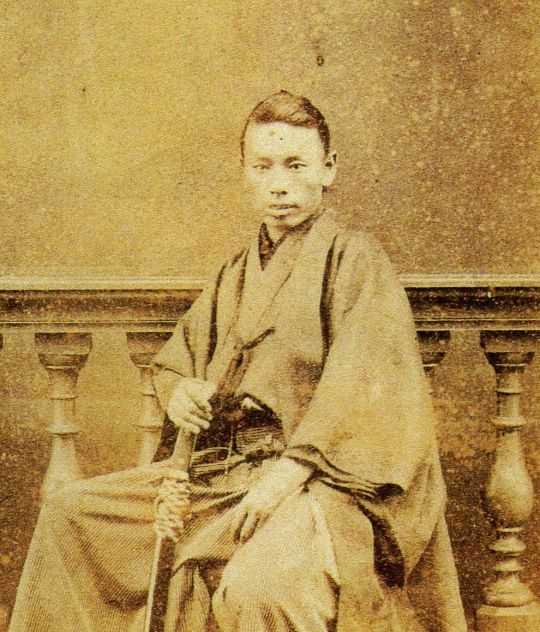
Inoue Mita (Kaoru) (Source: 幕末写真の時代)
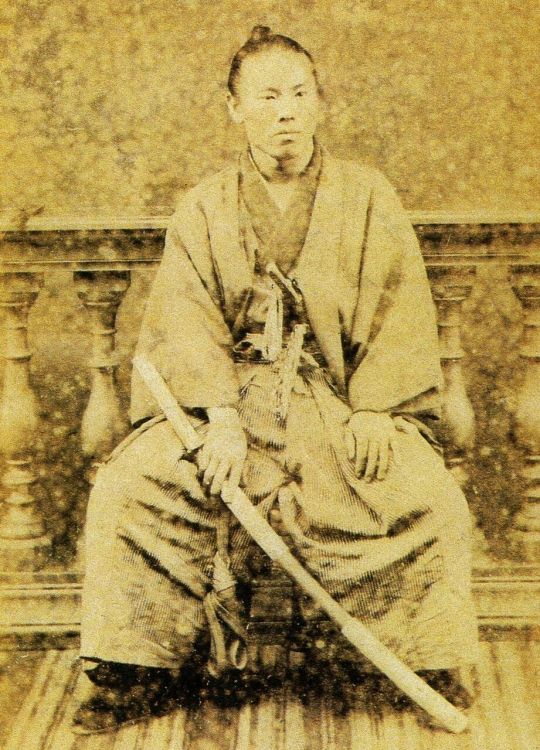
Ito Shunsuke (Hirofumi) (Source: 幕末写真の時代)
Many of them have a full head of hair (a chonmage without shaving the forehead).
(By the way, I looked at some old photographs, but I couldn't find anyone who had a "warrior-style" chonmage. Was it really popular? It's a mystery.)
And from these two people who are very close to Okita Souji:

Kondo Isami (Source: 幕末写真の時代)

Hijikata Toshizo (Source: 幕末写真の時代)
Kondo Isami also has a full head of hair.
There is no photo of Hijikata Toshizo before the hair cut, but in the first year of the Meiji era, with this amount of hair, he probably had a full head of hair before.
I don't have any materials, but I think that Kondo Isami's adoptive father, Kondo Shusuke, also had full hair.
Kondo Shusuke was not a samurai, and he was a master at catching a snake and eating it raw.
I don't think he cared too much about his appearance.
Shusuke is a great teacher who taught Okita Souji from an early age.
Considering that his respected young mentor Kondo Isami and his peer Hijikata Toshizo also had a full head of hair and hated furu (a relaxing bath), it seems that Okita Souji may have had a full head of hair from an early age.
And, as for his motoyui..., this post has become too long, so I will continue next time.
References
秘蔵古写真 幕末 日本カメラ博��館 監修 山川出版社 2019-04-21
幕末 : 写真の時代 第2版 小沢健志 編, 渡辺義雄, 小西四郎 監修 筑摩書房
Bakumatsu Guide https://bakumatsu.org/
幕末奇談 (中公文庫) 子母澤寛 中公文庫 寛中央公論新社 2014-01-23
沖田総司・おもかげ抄 森満喜子 新人物往来社 満喜子 1999-04
沖田総司伝私記(2007年刊行) 菊池明 新人物往来社 明中経出版 2007-03-23
なんでもまとめサイト 海援隊隊士まとめ https://we.eek.jp/matome/
Wikipedia
14 notes
·
View notes
Text
The Harada Dojo where Kondo Isami first learned the sword
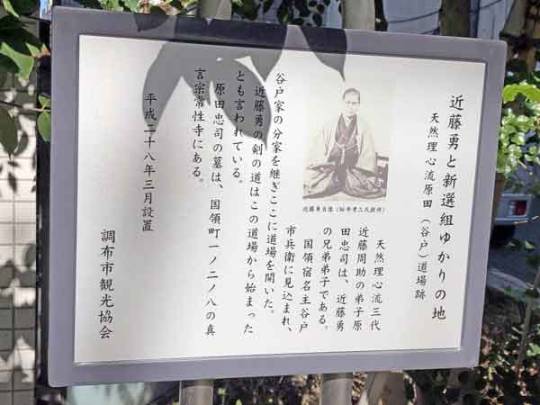
The Harada Dojo is a dojo in Chofu City, where it is said that Kondo Isami learned the Tennen Rishin-ryu for the first time .
It is now an apartment, and there is an information board about Kondo Isami and the dojo next to it.
This post will introduce the remains of the Harada Dojo, which can be said to be the catalyst for the existence of "Kondo Isami".
Directions
Address: 1-30 Kokuryocho, Chofu City
How to get there: 5 minutes walk from Fuda Station on the Keio Line
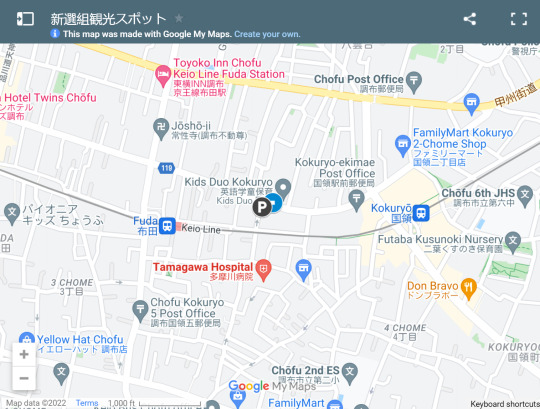
Map of Harada Dojo Ruins
The ruins of the Harada Dojo where Kondo Isami learned the sword for the first time
Information board at the place where Kondo Isami learned the sword

Harada Tadashi Dojo Ruins
Harada Tadashi opened a Tennen Rishin-ryu dojo in a building that was previously the Kokuryo Inn.
According to one theory, Kondo Isami went to this dojo to learn the Tennen Rishin-ryu.
It is also said that Harada Tadashi saw talent in Kondo Isami and brought him to Kondo Shusuke (who later became the adoptive father of Kondo Isami) .
After losing the battle of Toba-Fushimi, the Shinsengumi changed their name to Koyo Chinbutai and went to Koshu (Yamanashi), passing through the Koshu Kaido road in front of this dojo.
At this time, there is an anecdote that Kondo Isami stopped by at the Harada Dojo to greet his former teacher.
Harada Dojo Site Information Board Location

The information board for the remains of the Harada Dojo is in an inconspicuous place
It is about a 5-minute walk from Fuda Station on the Keio Line . In front of an apartment called Fermier, it doesn't stand out, so you can overlook it easily. It was lined up with the signboard of "Tanito Farm". Next to the condominium is the road to Tanito Farm, and next to it is a children's English school called Kids Duo.
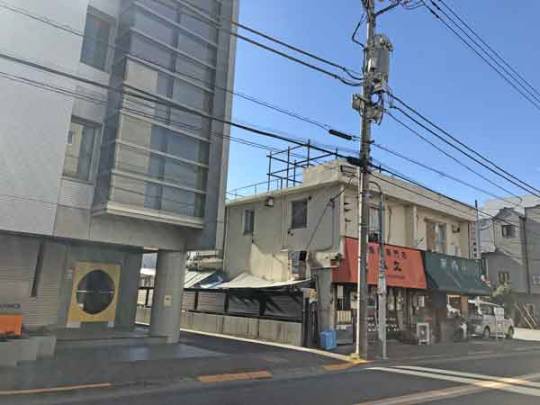
The scenery opposite of the Harada Dojo ruins
There is a "Shinju" and a chicken specialty store diagonally opposite.
Who was Harada Tadashi who taught Kondo Isami the sword?
Harada Tadashi was a disciple of the Tennen Rishin-ryu and a student of Kondo Shusuke. He was an assistant instructor for Kondo Shusuke at the Shieikan.
The Kojima family in Machida also recorded that Harada Tadashi often arrived for practice before Kondo Isami arrived.
The dojo used to be the Kokuryo Inn, owned by a branch of the Tanito family which Harada Tadashi belonged to.
Kondo Isami came here, and Harada Tadashi discovered his talent and brought him to Kondo Shusuke.
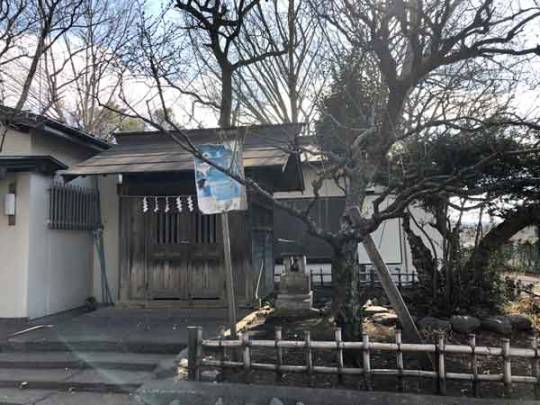
Near the Tenjin Shrine in Fuchu, where there was an outdoor tournament to announce Kondo Isami's succession as the master of the Tennen Rishin-ryu
Later, when Kondo Isami held an outdoor tournament to announce his succession as the master of the Tennen Rishin-ryu, Harada Tadashi participated in the main tent as a metsuke (a role that observed and reported battle movements).
In the main team were Kondo Isami with the role of commander, Okita Rintaro (the husband of Okita Souji's sister) as bugyō (military commisioner), Okita Souji in the role of taiko drums, and Inoue Genzaburo in the role of kane gongs.
Hijikata Toshizo and Sannan Keisuke were in the Red Team and were fighting against the White Team led by Sato Hikogoro.
As a high-ranking disciple of the Shieikan, and as an assistant instructor to the previous master, Kondo Shusuke, it seems that he had crossed swords not only with Kondo Isami, but also with the other members who would later become the Shinsengumi.
Harada Tadashi died in Meiji 26, and his grave is located in the graveyard of the Tanito family at Jyosei-ji Temple (1-2-8, Kokuryo-cho, Chofu City) near the site of the dojo.
9 notes
·
View notes
Text
Okita’s last letter, where he talks about pickles
12.11.1867 To Miyagawa Otogoro (elder brother Kondo) from Okita

[See full-sized image]
English Translation
The winter cold is now upon us, and at this time, I wish you good health, fortitude, and courage. I thank you for the letter you gave me. With respect to Hijikata and Inoue, I report that they were unharmed on the road and returned safely to the headquarters on the 3rd of this month. So you don't have to worry about them. When I heard about the Old Sensei's illness, I really wanted to go with them to Edo, but unfortunately I couldn't because of my own illness. But lately, every day I've been feeling better and I think I'll get better soon, so don't even worry. Please give my regards and best wishes to Sensei. That's all for now. We'll talk about the rest when we meet sometime. I apologize for the brevity. November 12 Okita Souji Miyagawa Otogoro-sama In this cold season, please take care of yourself. Thank you very much for sending me the best misozuke ever. Secondly, please convey my greetings to everyone else.
Original
(http://bakusin.com/kenka/shomen/shokan3.htm)
向寒之節ニ御坐候得共、益御勇猛被成御坐珍重之御義奉南賀候。陳ハ土方、井上両氏之義茂道中無滞、当月三日帰局致候。此段御休意可被下候。 扨、其節者御尊書送り被下、難有拝見致候。拙者義も老先生病気ニ付、是非共東下致心組御候得共、病気故何分心底ニ不相叶候。乍併当節は日増快方ニ赴、此分ニ而ハ最早大丈夫ニ可被存候間、乍憚御安意可被下候。猶又先生事万端宜敷奉願上候。先は其節迄、書余は拝顔之上万々可申上候。 恐々不具。 十一月十二日 沖田総司 宮川音五郎様 尚々、時分柄寒気御厭可被下候。何よりの味噌漬被下、難有奉存候。 二ニ御一統様江も貴君より宜敷御伝声奉願上候。

Commentary
fushigi-dono:
Just like last time, Okita wanted to go with Hijikata to Edo, but they didn't take him again :( But this time for reasons beyond anyone's control.
This is Okita's last letter, written just over six months before his death. It's the only one where he mentions his illness. And that's what Okita's all about - he's "getting better"! "You don't have to worry about him, he'll get over it, it's no big deal", you think. What nonsense! By the way, at that time he was probably really feeling better, because the famous "five dead bodies and one bewildered Okita" episode was about to happen [T/N: Not sure what incident this is referring to]. So far he was still able to hold his sword.
The "Old Sensei" was Kondo Shusuke, Kondo Isami's adoptive father. He died on October 28, a week after Hijikata left Edo and two weeks before writing this letter. But either "the news didn't travel very fast those days" and no one in Kyoto knew about it yet, or they simply didn't tell the boy so as to not upset him.
Hijikata and Gen-san took care of him by bringing food from Edo to feed him at home. Since he couldn't go home on his own, he could at least make himself happy!
But Okita did manage to visit his homeland in the end, for the first time in 5 years, unlike some people. He was taken there by ship. But that was only later...
Misozuke - these are vegetables, fish or meat, marinated in miso paste, to which sake is added. One of the oldest ways to make Japanese pickles. Miso gives them their flavor, and this process takes a long time, sometimes years. The longer the vegetables remain in the brine, the better their taste.
Fish or meat are unlikely to be marinated there for that many years, but still this is a good way to preserve food for a long time, which is especially important in winter.
This is what a vegetable misozuke looks like:


And here's fish:


And here, it shows how to make meat misozuke (pork belly, chicken thigh, and pork loin). There, in addition to sake, they add myrin (sweet rice wine) to miso paste. The meat placed in this mixture is put in the refrigerator for a couple of days, then roasted. It looks appetizing :)


Well, here's a bit of Japanese. I can't help it:
何より之味噌漬 - "nanyori no misozuke" he writes, means "the best misozuke ever" :)
And unlike Hijikata, Okita doesn’t write "hitotsu" (”一” at the start of a sentence, which means “Firstly”) in any of his letters. He starts sentences with “陳ハ” - ”nobureba” (meaning “thus” or “getting to the point”); “猶” - “nao” (meaning “also”, “furthermore”); “尚々” - “nao” (meaning “also”, "above all”, “moreover”); “又” - “mata” (meaning “and” or “besides”), etc.
And he writes "Secondly": “ニニ”, without "Firstly". Their styles are so alike, but so different!
bakusin:
This is Souji's last letter among those confirmed to be in existence. He reported that Hijikata Toshizo and Inoue Genzaburo had returned safely from their trip to Edo (on November 3, as stated in Toshizo's letter) and wrote, "I thank you for your letter on that occasion. I had hoped to accompany them to see the "Old Sensei" when he’s ill, but I could not do so because of my own illness. However, I’m getting better day by day these days, and at this rate, I believe I will be fine. Please give my best regards to Sensei. I will talk to you again when I see you again. Please take care of yourself as it is cold. Thank you for giving me the best miso pickles." He writes here for the first time that he is ill. Perhaps this was in response to their concern in a letter about his advanced tuberculosis, a condition that could no longer be concealed from others and the news had reached as far as Tama. In the following month, he was in Fushimi, and was transported to the rearlines in Osaka with the wounded Kondo, so there was no way he was "getting better soon”. The "Old Sensei" refers to Kondo Shusuke, who was in the midst of a long illness and was Souji's mentor. However, Shusuke had passed away on October 28, only a few days before this letter was written. It took some time to contact people, and Souji probably did not know about it at that time. I wonder what Soji's feelings were when he learned of his master's death at the time of his arrival in Tokyo, as he had never been able to visit home since going to Kyoto. At the end of the letter, he was delighted to receive a gift of miso pickles, a nostalgic taste of his hometown, from the Miyagawa family, which may have helped his sick body eat a little better.
27 notes
·
View notes
Photo
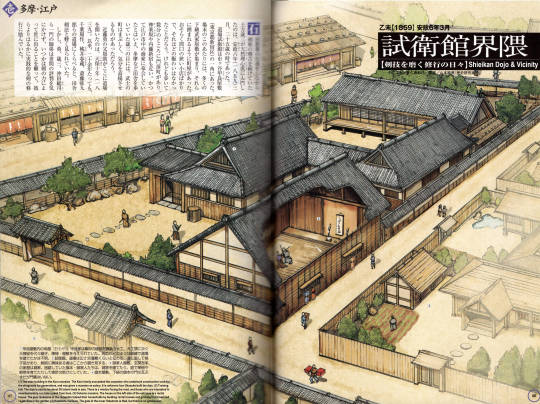
Shieikan Dojo and vicinity
From Illustrated Shinsengumi
3rd month, Ansei 6 (1859)
Legend
The main building in the Kora mansion. The Kora family succeeded the carpenter who undertook construction work for the shogunate for generations, and was given a mansion as salary. It is unknown how Shusuke turned it into his dojo.
Training hall. The dojo is said to be about 30 tatami mats in size. There is a window facing the road, and those who are interested in swordsmanship can take a peek from here.
Gokenin mansion. The house on the left side of the entrance is a rental house. The poor Gokenins of the Hatamoto helped their households by building rental houses and growing fruit trees and vegetables in the garden.
Hatamoto mansion. The gate of the lower Hatamoto is tiled, but there is no gatekeeper.
Hijikata Toshizo, who had been practicing swordsmanship while selling Ishida Sanyaku medicine, began his career in Tennen Rishin-ryu when he was 25 years old in 1859 (Ansei 6). The dojo was in the corner of Ichigaya Kora Mansion (Shinjuku-ku, Tokyo). Many low-ranking samurai residences gathered around this area at the end of Edo, and there was a townhouse surrounded by them. Perhaps he wasn't so busy with all the small shops with narrow frontages. However, there is Monzen-cho within a few minutes' walk, and Kagurazaka and Naito Shinjuku are also nearby. And even though he was dedicated to merchant houses all over Edo City, the samurai town would have been dazzling and uplifting to the eyes of Toshizo, who was walking in the countryside such as Tama.
It was in the tenth year of Tenpo (1839) that Kondo Isami's father, Shusuke, opened a dojo here. Since then, even after more than 20 years, compared to the dojos of Chiba Shusaku, Shunzou Momonoi, and Saito Yakuro, it was lightly regarded as a countryside swordsman.
However, Isami, Toshizo, Okita Souji and other teachers and pupils did not care about their reputation in the world. He was working hard to practice the sword far more practically than they were, hoping that one day he would come out to the world with the power of the sword.
7 notes
·
View notes
Photo

Old view of the Tama Region
From Illustrated Shinsengumi
Tenpo 6 (1835)
The illustration depicts the scenery around Hino in Tama, where the Hijikata Toshizo family and Sato Hikogoro's mansion were located, and the Tama and Asa rivers flowing gently. Kamiishiwara, where Kondo's birthplace was, is outside diagonally to the right of the screen.
Kondo Isami was born in the 5th year of Tenpo (born in Kamiishihara Village, 1833, 4 Tama-gun. The Miyagawa family were wealthy peasants, and even built a dojo at home. Kondo Shusuke came to teach him the Tennen Rishin-ryu and saw his extraordinary skills. He was adopted as successor.
Sato Hikogoro, the owner of Hino Inn, also had a dojo at home. His wife's younger brother Hijikata was born in the 6th year of Tenpo and was one year younger than Kondo. Kondo had been devoting himself to the goal of following the path of the sword from early on. It is said that Hijikata, on the other hand, was late in pursuing the path of the sword. However, he put his heart into it and went out with bamboo sword everywhere while selling his family’s traditional Ishida Sanyaku medicine.
The Tama and Asa rivers run near Hijikata's birthplace. It goes without saying that it was a peaceful landscape. As with the scenery of his hometown, when Kondo and Hijikata were dedicated to practicing swords, it was a period of peace. Eventually, however, the era erupts into chaos, and the fates of the two of them soon become entwined.
4 notes
·
View notes
Note
My most knowledgeable Kondou knower, can I ask you what makes a Kondou RP blog an actual decent Kondou RP blog? What does it take to get this man on paper correctly? What are your tips (if you'd not mind to share!)
*blush blush* you flatter me. D: I can rattle off some info but it’s important for me to toss out the disclaimer: writing is based on interpretation so if anyone happens to disagree with what I lay out here, please go on with how you want to write and ignore me. Why am I saying that? I know how easy it is to see some random post on writing or characterization and feel demotivated. I’m majorly MAJORLY salty about how modern media snubs him and pushes him aside, so if you’re interested in writing Kondo’s character, I’m already supporting you.
As with any character, it depends on what universe/series you’re writing for but I think all the Kat-chans I’ve encountered can fit into some of the same qualities and share the same historical background.
- He is an ideal samurai through and through. That means he’s loyal to the core of his very soul to the Tokugawa regime and sticks to his convictions. He will die for the shogunate. He will send his soldiers to die for the shogunate. Protecting the Tokugawa is his number one priority.
- He has great pride in being a samurai and honoring what it means to really be one because of his roots. Though his father was well-off, he still hailed from a farming family which was the lowest societal class. Before the Edo era, shogun Toyotomi Hideyoshi banned the ownership of swords and other weapons from anyone who wasn’t a samurai. When you’re living in rural areas though, the government can’t protect you from thieves and the like, so farmers studied kenjutsu to look after their own lands and possessions. Kondo was dedicated in his practice and while his father was away, he (as a teenager) and his brothers stopped thieves from raiding their house. His talents were noticed by Kondo Shusuke from the Shieikan, who was looking for an heir. Shusuke went on to adopt him and therefore taking him from the lowest class to the highest. Amazing, incredible. You’re doing great, sweetie!
- At this point in the Edo era, samurai were said to have become lazy as there were no wars to fight in. Kondo rejected this and was dedicated to being what he believed was the ideal spirit of bushi. He was respectful in how he spoke to superiors and other samurai.
- He went through several name changes throughout his life. He was born as Miyagawa Katsugoro. Upon adoption, he took the name Shimazaki Katsuta. When he succeeded in taking over the Shieikan, he was known as Kondo Isami. Toward the end of his life when the Shinsengumi returned to Edo, he was known by the aliases Okubo Tsuyoshi and Okubo Yamato to protect his identity from Shinsengumi enemies quickly closing in on the east.
- He could be good-natured around his friends and had a sense of humor (yes, I’m talking about the good old fist in the mouth) but don’t mistake this for stupidity or naivety. He was extremely knowledgeable about politics and current events. He could debate and wasn’t intimidated to call out anyone on their bullshit. He had the ear of Matsudaira Katamori and even the shogun at one point.
- He was a born leader with magnetism who was capable of inspiring and commanding the respect of those around him. The first members of the Shinsengumi had sworn loyalty to him as their teacher at the Shieikan and stayed at his side for most of the war. Even after Nagakura split from the group much later citing disapproval of Kondo and Hijikata’s “egos”, he went on to build a grave to honor them.
- Speaking of Hijikata, a lot of media today portrays him as the main decision maker with Kondo as some frivolous figurehead who doesn’t know left from right. Pshhh, no. If Hijikata somehow could know his popularity succeeds Kondo’s in this age, I wager he’d be ridiculously upset. Kondo lived to serve and protect the shogunate as Hijikata lived to serve and protect Kondo. He was instrumental in forming the Shinsengumi and absolutely had say in many things, but that didn’t make Kondo irrelevant or incompetent.
- Kondo was a warrior. He killed his enemies, and a lot of them. I can sit here and romanticize about how he was a nerd as a kid who loved reading or how he practiced calligraphy at night in Kyoto, but it can’t be forgotten that he was a soldier fighting a war. He’d seen some shit. He’d done some shit.
- Let’s talk about the Roshigumi! Hundreds of ronin were rounded up in the east by Kiyokawa Hachiro. They would march to Kyoto to stop anti-Tokugawa forces (lookin at u, Choshu) in their tracks. Upon arriving in the west though, Kiyokawa was like “lmao jk yall. we’re actually opposing Tokugawa and now we all have to walk back to the east and have a battle in Yokohama.” Kondo, ever loyal to Tokugawa, refused. He and his Shieikan men stayed behind and troublesome Serizawa did too since he had no place to go. Serizawa refused to acknowledge Kondo as the leader, so they compromised on having both of them lead. We all know what happened there, Serizawa did a lot of terrible things. Kondo had to clean up his messes and make excuses for his behavior, while trying to make a name for the Roshigumi and gain enough rep to be noticed by Matsudaira. Eventually, he did gain that attention and from there, Matsudaira went on to rely on Kondo’s expertise and his men to keep Choshu down. Like his adoption into the samurai class, this was no easy feat and I’m immensely impressed that he managed to do this.
- HE’S NOT AN OLD MAN. ffs, another thing most modern media would have us believe is that he’s a decade or more older than Hijikata. Kondo was born in November 1834. Hijikata was born in May 1835.
- He was said to be average height (around 5′4/167-ish cm iirc?) with a very athletic build from all the training.
- The last Tokugawa shogun Yoshinobu (*HISS*) and naval commander Katsu Kaishu (*DOUBLE HISS*) expected Kondo and his Shinsengumi to either die off or disband after they fled Kyoto. When he showed up with his men in the east, they didn’t know what to do with them. Katsu then ordered Kondo to change the group name from Shinsengumi to Kouyo-Chinbutai and take Kofu castle where they were severely outnumbered. Basically, he was giving them all a place to die. They’d managed to get some promises of recruits which never showed up, lost the battle, and needed to retreat. The group then settled temporarily in Nagareyama.
- Though there’s no official confirmation, he was executed for a crime he very likely didn’t commit: the assassination of Sakamoto. A member of the Mimawarigumi claimed responsibility for it years later. Sakamoto was a legend in his home of Tosa and people were understandably infuriated at his murder. Kondo was the scapegoat for it. He surrendered himself at Nagareyama to allow the remaining soldiers to escape. Hijikata wanted to surrender himself at the same time so he would die with Kondo, but Kondo insisted he keep carrying their banner and leading the group. I’m not crying, you’re crying.
- His sexuality and relationships are wide open to your interpretation. His marriage to Tsune was arranged, like many were in that time period. He had concubines in Kyoto, Miyuki being the most famous. These are broad statements I’m making here that can’t speak for every person but.... Same sex relationships (marriage/procreation) weren’t accepted because the point of that was to produce children...but same sex relations (physical and emotional connection) among men were rampant. There’s historical evidence from a letter Kondo wrote that he was perfectly aware it was going on in the Shinsengumi. Shinsengumi members went on to say Kondo and Hijikata were two halves of one whole. Again, Nagakura built them a joint grave. You decide. I already have. lmao
- Whether you romantically pair them together or not though, Kondo was the most important person in Hijikata’s life and vice versa. They had an indestructible bond, not even severed by Kondo’s execution. Hijikata fought on to clear Kondo’s name after his death.
WOW THIS GOT LONG......
The tl;dr here is, if I were writing Kondo in rp, these are the qualities I would give him: committed to living his life under bushi code (which has likely been overly romanticized compared to reality but hey), committed to serving the Tokugawa, can be friendly with his closest friends but a little colder with soldiers/others he isn’t close to, knows how to fight, knows politics, knows how to debate and hold his own. Genuinely likeable by nature, has the respect of his followers, has the respect of Matsudaira after proving himself. Has fierce loyalty from his men and even after some leave the group, they won’t let anyone drag his name. Strong-willed and stubborn on political issues he backs. Reflective and thoughtful in down time. Reliable to those who depend on him. Quiet and calculating in groups but absolutely willing to speak up when he disagrees. And never ever ever forgiving of the Satcho coup, or anyone who supports it.
21 notes
·
View notes
Text
Sato Hikogoro
Hikogoro Sato The eleventh and last wholesaler of the Sato family, who has managed the Hino Hongo Michigoku centering on the post station of Hino called "Tama no Yonezo" for generations. Hino-juku also managed the transfer of Hino on the Tama River. * In Hino-juku, it was called "Toiyaba" instead of "Honjin", and it was called the wholesaler role because the head of the Honjin was both the head and the wholesaler. He is also a person who consulted with the Shinsengumi who just went to Kyoto and provided financial support. He has a strong sense of selfishness and is a person who values righteousness and is respected by people. ● September 25, 1827 Born in Hino-juku, Tama-gun , Musashi-kuni (currently Hino-honmachi, Hino-shi, Tokyo) as the eldest son of his father Hanjiro and his mother Masa. Childhood nickname Kota. In the 8th year of Tenpo (1838), his father died suddenly, and at the age of 11, Hikogoro succeeded the owner of Hino Hongo and the owner of Hino Yado wholesaler, Hino Union Village, and will manage Hino Hongo Sansengoku. In 1845, he married Nobu Ishidamura (sister of Toshizo Hijikata). January 18, 1849 A fire broke out at a farm across the road from the Sato family. Over a dozen houses, including the Sato family, were burned down by the north wind. In addition, a street demon incident occurred in which two people, including Hikogoro's grandmother, were killed. Around this time, due to the turmoil of Perry's arrival and the trend of jōi Security was disturbed due to the increase in burglaries. Hikogoro strongly feels the need to maintain the security of the village.
In the third year of Kaenaga (1849), he asked Matsugoro Inoue, who is concentric with Sennin Hachioji, to introduce him, and became a student of Shusuke Kondo (the adoptive father of Isamu Kondo), the third generation of the natural rationale. We will set up a dojo for training in a corner of our house. In the first year of Ansei (1854), he worked hard on martial arts and became a natural rationale. It seems that the number of people who have influx of natural reasoning has increased rapidly by remodeling the Nagaya Gate to make it a kendo hall. Several times a month? Isamu Kondo and others from Edo Seieikan came to practice and taught. Also, when the Shogunate builds a battery for defense off the coast of Shinagawa (currently Odaiba), it makes a donation. * Shusuke Kondo is also donating. September 20, 1855 We will exchange a cup of brother-in-law with Kojima Shikanosuke, the owner of the Onoji Village Association in Machida, and Isami Kondo. August 1858 Shusuke Kondo of Hino-juku dedicates a donation to Yasaka Shrine. August, 1861 (1861) Isamu Kondo, the 4th generation of the Natural Rishinryu Souya, shows off his name at Daikokutama Shrine. Hikogoro served as the white general in the red and white battle. In 1862, cholera spread and many people died. The Buddha coffins lined up on the highway. Hikogoro invested his private fortune to administer drugs and received white silver from the shogunate. Bunkyu 3rd year (1863) The members of the escort hall will participate in the recruitment of the Shogun Roshigumi. Hikogoro also wanted to participate, but since he has a job as a master, I will entrust it to his brother-in-law, Toshizo Hijikata. I took over the Shinbun rolls of the natural Rishin style, practiced in various parts of the Tama area on behalf of the sect, and took care of the students. * Kondo and his colleagues were in a situation where they couldn't get a salary because they started from NEET when they were just starting out. Hikogoro provides financial support and consults. There were frequent exchanges of New Year's cards and letters between Kondo, Hijikata, Okita and others, and Hikogoro and Kojima . One of the letters Hijikata sent to his relatives in Uedamura said, "Ask Hikogoro-san for details." Also, even after becoming a Shinsengumi, when I heard various rumors, I was worried that "No matter how strong you are, if the end soldiers lose their rumors, the impression of the Shinsengumi will get worse." I am sending a letter. July 19, 1864 (Kinmon Incident) Rumors arrived in about a week, and there was a false alarm that Kondo died in the war. Hikogoro confirms Kondo's safety by inquiring about the Aizu clan's residence in Edo and hearing from the Aizu clan who returned from Kyoto, and tells Kojima. Farmers were collected in the Tama region, and the Hino Farmers' Corps was organized around the Hino Inn Association. June 1866 The Tama River and Asa River are also affected by poor crops due to unseasonable weather and floods caused by heavy rain. It will often stop the river (cannot cross the river), and prices will rise. Although the relief campaigns for the poor were collected and relief rice was issued, a peasant riot occurred in Takeshu Ano and Naguri. (Ikki Takeshu) Involving the farmers of the villages, the number of people swelled to several thousand at one time , and the place where Iino and Tokorozawa and the wealthy merchants and farmers were destroyed and tried to rush to Komimura (currently Komiyacho, Hachioji City) was concentric with Hachioji and farming. Soldiers are dispatched. Repulsed on the opposite bank of the Tama River, Hino-juku and Hachioji-juku escaped the difficulty of being beaten. The eldest son, Gennosuke, also participated in the suppression with gun art and shooting swords. * Hijikata, who returned to Edo to recruit soldiers, admired Gennosuke's gun maneuvering and asked him to come to Kyoto and become a professor of the Shinsengumi. Hikogoro wanted to go, but he gave up because of the great opposition from Nobu. March 1867 Twelve Satsushu Ronin threaten villages in the name of raising military funds. At the order of the deputy officer to get rid of him, Hikogoro took six farmers to the Hachioji pot Iseya where they were staying. Defeat several opponents with short guns and capture the rest. * When Kondo heard this story later, he was surprised, "It's too dangerous to interact with a gun! I haven't done it yet." January 1868 (1868) Battle of Toba Fushimi The new group will return to Edo according to the general. March Koyo Relief Corps organization Hikogoro arranges troops. Called Kasugamori, we will organize and participate in a farmer's corps (Kasuga corps). Lost in the battle of Katsunuma. * In response to the opinion that the bridge should be burned to block the enemy army at Saruhashi, Hikogoro said, "The bridge is important to the locals. Especially once this difficult construction Saruhashi is burned, the locals is it but the trouble no matter how. the burn the bridge is opposed to absolute, " and, seems to have put a stop. 2000 new government troops will come to Hachioji and scrutinize passers-by with Yanaseya in Yokoyama-cho as the headquarters of the chief of staff, Itagaki Retirement. Since he was close to the Shinsengumi executives and sent Kasuga Corps to the army, he was searched for "Hino's Hikogoro must be found even if the grass is rooted", and the Hikogoro family escapes to scatter without time to make an agreement. Hikogoro went to Daizoin in Komiyamura Kitahei with his youngest daughter Asa and his youngest daughter. I thought it was a relief to be hidden by the nun, but the soldiers came and escaped with a short hair. It was already about midnight when I arrived at Mr. Shigehira's house in Nimiyamura, Nishitama-gun, and then at the Hanyu family in Okunomura. On the other hand, his eldest son, Gennosuke, was so ill that he was so weak that he grabbed the room and walked. Carried by his younger son, Tetsuzo, he escapes with his neighbors, Hyozo and Inoue Locknosuke, but is caught and asked at the Hachioji headquarters. He really doesn't know where his father is and can't answer no matter how many questions he asks. Itagaki came and said, "It's strange that a child doesn't know where his father is, but as a child, even if he knows it, it's filial piety that he doesn't confess." And release everyone. Hikogoro's mansion was searched first, and 19 guns were picked up, looking for the attic and underfloor. Kondo appointed Okubo Ichi and Hijikata appointed Katsumi Fune, and it seems that the Hikogoro family had reached the point where they couldn't make a difference from the main office, Saigo. July 1869 Hijikata's small surname, Tetsunosuke Ichimura, comes to Hikogoro's house and hands over Hijikata's relics. http: //senjouno-kizuna.so-netsns.jp/? M = pc & a = page_fh_diary ... In 1872 , the name was changed to Toshimasa when the family register was created. We will carry out the Tama River embankment work. In 1873, he became the mayor of the 9th Great Ward of Kanagawa Prefecture (63 villages of Nijuku in the Minamitama district). We will do our best to attract schools. January 17, 1874 His wife, Nobu, died at the age of 47. The Meiji government will issue a decree not to blame the spirits of the war dead who became enemies in the morning. Hikogoro plans to build a memorial monument with Kojima et al. In 1878, Tama-gun was divided into north, south, east and west according to the county-ward, town-village organization law, and became the first mayor of Minami-Tama, Kanagawa Prefecture. In 1881, Rentaro, the third son, died at the age of 22. Hikogoro resigned from the first mayor of Minamitama and supports the free civil rights movement that was becoming an officer. In 1888, the monument to Yuyuki Marubushi is completed at Takahatayama Kongoji Temple. He died on September 17, 1902, at the age of 76. Bodaiji is Daisho-ji. ● Hikogoro has a hobby of haiku and had the title of Kasuga-an Shengsha. It seems that he had a close friendship with Hijikata's eldest brother, Tamijiro Hijikata (Kazantei Ishisui), who had a common hobby of haiku. Kondo memorial clause to Isamu: Tiger and flowers defunct scattered not immediately summer memorial clause to Toshizo Hijikata: wait Kai also Keri Nakutekie rainy season of the month reference Shinsengumi-related books (details omitted) other, and the Internet, the television or the like to reference Did. The differences depending on the material depended on whether each material was compared and listed together, or what was judged to be the most credible.
6 notes
·
View notes